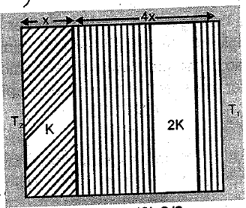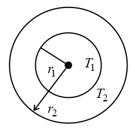Heat Conduction in One Dimension
Heat Conduction in One Dimension: Overview
This topic covers concepts such as Heat Transfer, Thermal Conduction, The Steady State Heat Flow, Heat Flow and Area of Cross Section, Heat Flow and Temperature Gradient, and Coefficient of Thermal Conductivity.
Important Questions on Heat Conduction in One Dimension
Which one is having the lowest thermal conductivity?
What is the Searle's apparatus?
What is Searle's method for thermal conductivity?
Two heater coils separately take and to boil a certain amount of water. If both the coils are connected in series, the time taken to boil water is
Which one of the following is not the example of the athermanous medium.
Which one of the following is not the example of the diathermanous medium.
Three rods (lengths made of the same material and having the same area of cross-section are joined as shown in figure. The end points and are maintained at constant temperatures and respectively. Assuming that there is no loss of heat from the surface of the rods, find the temperature that the junction ultimately reaches.

Two rods of the same length and diameter having thermal conductivities and are joined in parallel. The equivalent thermal conductivity of the combination is
A long metallic bar is carrying heat from one of its ends to the other end under a steady state. The variation of temperature along the length of the bar from its hot end is best described by which of the following figure?
Two rods (one semi-circular and other straight) of the same material and of same cross-sectional area are joined as shown in the diagram. The points and are maintained at different temperatures. The ratio of the heat transferred through a cross-section of a semi-circular rod to the heat transferred through a cross-section of the straight rod in a given time is

If the power consumption is ,
The thermal conductivity of air is:
A partition wall has two layers of different materials and in contact with each other. They have the same thickness but the thermal conductivity of layer is twice that of . At steady state, if the temperature difference across the layer is , then the corresponding temperature difference across the layer is
The thermal conductivity of air is:
The temperature difference of is maintained between two ends of a uniform rod of length . Another bent rod , of the same cross-section as and length , is connected across (see figure). In steady-state, the temperature difference between and will be close to

A long metallic bar is carrying heat from one of its ends to the other end under steady-state. The variation of temperature along the length of the bar from its hot end is best described by which of the following figures?
The two ends of a metal rod are maintained at temperatures and The rate of heat flow in the rod is found to be If the ends are maintained at temperatures and the rate of heat flow will be:
The temperature of the two outer surfaces of a composite slab consisting of two materials having thermal conductivities as and of thickness and respectively are and . The rate of heat transfer through the slab in a steady state is with equal to

The figure shows a system of two concentric spheres of radii and and kept at temperature and respectively. The radial rate of flow of heat in a substance between the two concentric spheres is proportional to:

Three metal rods made of copper, aluminium and brass, each long and in diameter, are placed end to end with aluminium between the other two. The free ends of copper and brass are maintained at and respectively. Assume that the thermal conductivity of copper is twice that of aluminium and four times that of brass. The equilibrium temperatures of the copper-aluminium and aluminium-brass junctions are respectively-
